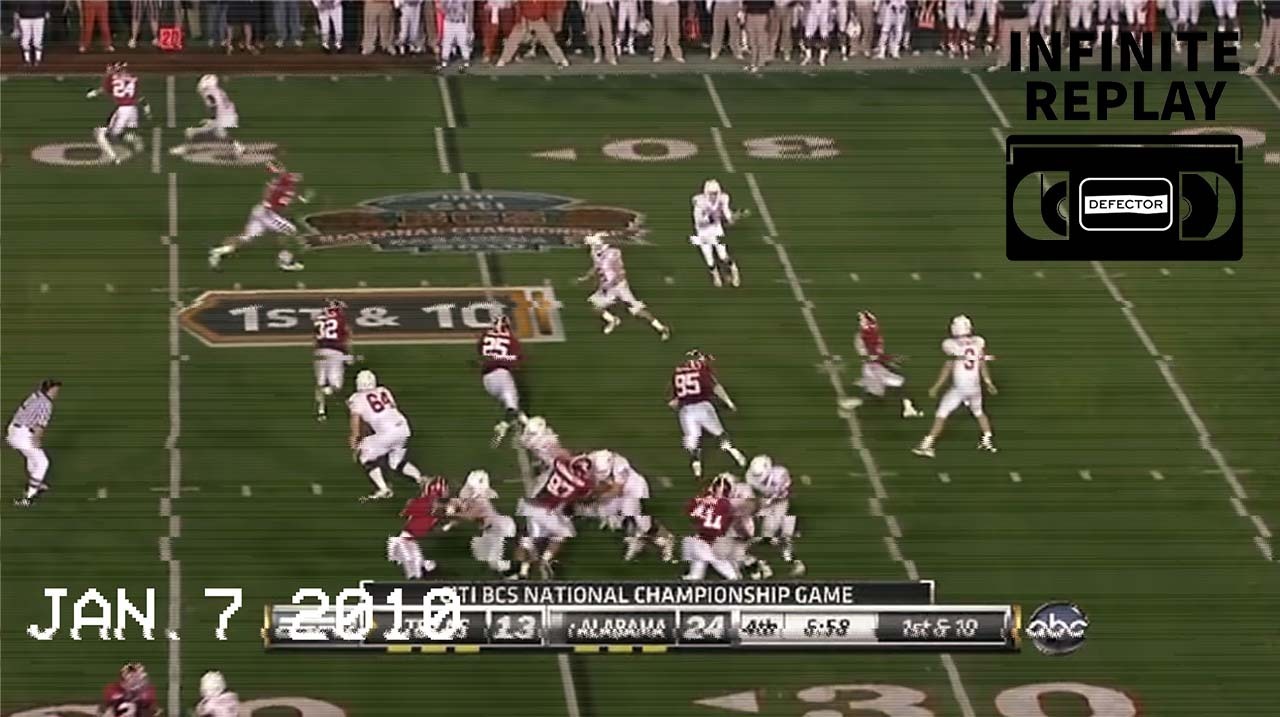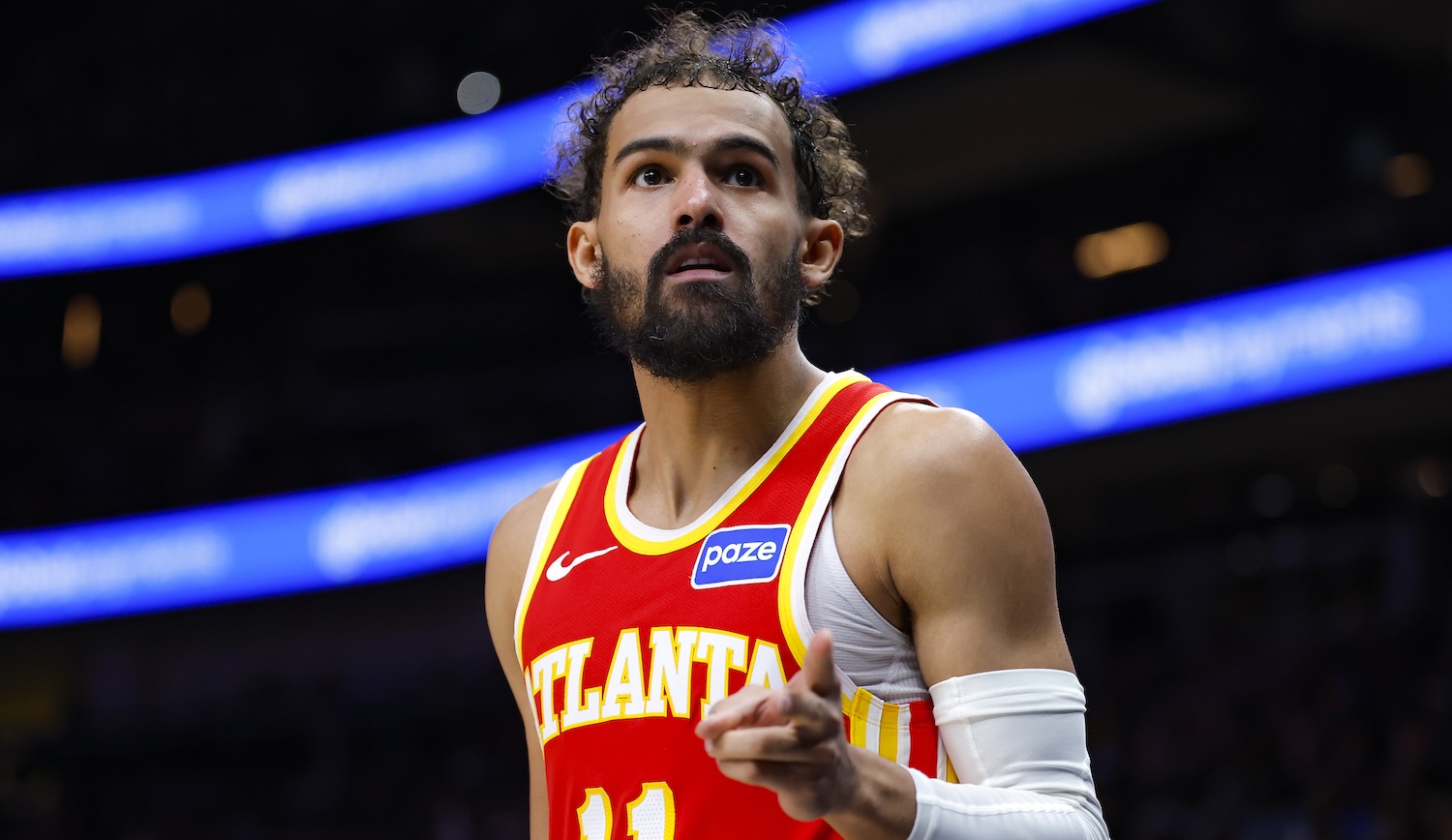Welcome to Infinite Replay, a recurring feature about the plays we can’t stop seeing over and over and over again.
There is one play from the 2010 National Championship game that all Texas fans remember. It was first-and-10 on the 16-yard line, and the game was still young. No one’s fate had been decided when the Texas Longhorns sent out three receivers near the line and a running back to stand next to Colt McCoy. The game was still tied at zero. Hope—that juvenile, naive beast we all accept at the beginning of every season and allow to take up residence somewhere beneath our sternum—still bounced at every snap, reminding us it was still alive. But here the ball was snapped, and looking around, McCoy saw no options. He ran, though not well, right into the side of an Alabama Crimson Tide lineman and fell, kind of lady-like, his knees together tilting to one side as he sat atop another defender. It looked harmless, normal.
A bad play, sure, but it was only first down. McCoy himself wrote later in The Players’ Tribune, “What strikes me the most was how normal the hit was. It was a hit I’d taken a million times.” But it wasn’t normal. Any good Texas fan remembers that play because after it, McCoy’s right arm was numb. He was done. But that’s not the play I think about every single time I watch a line of burnt orange jerseys waiting for the snap. No, the moment that plays on the insides of my eyelids when I blink is far less significant than that. It’s irrelevant, really. But it besets me, its legacy alive in every game I’ve watched since.
After McCoy’s injury, head coach Mack Brown put in Garrett Gilbert, a true freshman who had very little experience. McCoy still holds most major quarterback records at Texas because Mack Brown never took him out. The program, he seemed to be saying, was built around the McCoy-to-Jordan Shipley pass. So when Gilbert came into the game, he wasn’t ready. Before that game, Gilbert had thrown a total of 26 passes in college football games, and it showed. He threw interceptions. He looked sloppy, if clearly talented.
At halftime, it looked like a blowout. Alabama was up 24-6 and Gilbert had thrown two interceptions. But after halftime, Texas showed some life. They scored a touchdown, and we had a ballgame. 24-13 is not an impassable lead, even against Alabama. This was the score of the game when the play I remember so clearly happened. It astounded me, upon rewatching it for this column, just how irrelevant it is.
Texas is driving, and the pace feels good. Gilbert is completing pass after pass into heavy traffic, the passes clean and perfect. All of this is buildup. All of it is tension—nail-biting, leg-shaking, National Championship-level terror, because every single snap sends the ball into the hands of a boy with so little experience that even the announcers sound stunned when he makes a pass. But he does. He keeps completing passes. He is pulling off the impossible. Maybe. He’s not, but it feels like he might. He completes a 13-yard pass to Shipley for the first down. He throws an incomplete pass. He steps up again, and finds Shipley. Another first down. The camera zooms in on Gilbert and his eyes are shining. He sees the possibility, his future laid out before him, the National Championship attainable, and now we are at this haunting play.
There is 7:02 left in the fourth quarter. As you may remember, Bama is up, 24-13. Texas has the ball on the Alabama 25, and it is first-and-10. All this buildup to get to this play that doesn’t matter.
Texas lines up with four eligible receivers. There are three receivers closer to the Texas sideline and one close to the Bama sideline. Gilbert has a running back in the backfield with him. The center dips his head, and the ball is snapped perfectly five yards into Gilbert’s stomach. Gilbert fakes a handoff to the running back who swings around the left side of the line, fooling no one, just as he did the play before. There are four receivers, but Gilbert doesn’t look at three of them. They aren’t even running real routes. The plan was always to throw a bubble screen to the slot receiver, Dan Buckner.
The defense blitzes and Gilbert tosses the ball to his right, two yards forward and probably 10 yards laterally. Buckner catches it, but the play is already over. Alabama defensive back Justin Woodall is running to Buckner at full speed. He is there by the time the ball arrives, and he executes a perfect tackle, sweeping Buckner’s legs out from under him. The result is a three-yard loss.
This isn’t the play that lost Texas the game, and yet it is the play that symbolizes, to me, what was to come. I’ve always thought that there are two things that can make a bubble screen work: canny play design and misdirection, or a meaningful gap in talent between the offensive and defensive players. In other words, it’s the kind of play that I’ve always associated with good teams, the ones that are just a natural level above their opponents in both skill and strategy, running successfully. The Texas that I had grown to love was one of those teams, a squad that had been winning on talent while waiting for the rest of college football to catch up. When Woodall flew in from the defensive backfield to tackle Buckner and blow up that forgettable, throwaway play, it was obvious that Alabama had caught up.
When this game aired I was a junior in high school and, like most teenagers, was desperate to create a clear bright line between the life I wanted for myself and the life everyone around me seemed to think I wanted. One of the ways I did this was by deciding that I wanted to go to college at Texas, taking weekend trips down I-35 to hang around in Austin, making spreadsheets of available scholarships that might allow me to attend. Texas, I had decided, was going to save me: get me out of the exurb and the church, and what I now recognize as depressive episodes. My parents were supportive of this goal, but they were also quick to point out that I was choosing the losing team to root for. It’s not that I underestimated Alabama. I would never.
I grew up in an SEC household. Both of my parents went to Auburn, and much of my dad’s family went to Alabama. My grandmother’s ashes were scattered (perhaps illegally, we don’t ask this question) on the 50-yard line of Bryant-Denny Stadium in Tuscaloosa. My entire bloodline is full of (maybe rightfully so) SEC elitists. The Big 12, they ingrained in me at a young age, was a minor league full of teams who thought they were better than they were. Why watch a bunch of teams with no secondary throw for 350 yards when you could watch an SEC defense hold a fourth-and-1 with no problem? To be clear, my parents were rooting for Texas in this game. They would never root for Alabama. But they didn’t think it was the smart team to bet on. They were, of course, right.
Gilbert would throw a pass for a touchdown the very next play, but it wouldn’t be enough. He would fumble the ball and then throw an interception, and both would result in Alabama touchdowns. Texas would lose the game 37-21, and give Alabama their first national title since 1992. Since that win, Alabama has won the National Championship Game in 2011, 2012, 2015, 2017, and 2020. Texas has not won any.
If you talk to longtime Texas fans, many will point to that game as the beginning of the current slump. Texas lost to Bama, and in a way it felt (for Texas fans at least) a bit like a crown was transferred. At weddings, graduations, and barbecues, old Texas fans like to ask a hypothetical question: Does Texas win that game if McCoy doesn’t collapse? Does Bama feel as dominant if the quarterback in burnt orange has thrown more than 30 passes in uniform? What they are really asking, of course, is: Was that where it all went wrong? Was losing McCoy the fall of Texas?
But that fails to explain the continued downturn. McCoy was still going to graduate. The problem with the Texas football program wasn’t that McCoy got injured; it was that they didn’t plan for other schools to get better. On this drive, in this moment, that pass toward the sideline for a loss of three yards felt like a fluke, a mistake, a blip on an otherwise good drive. But I know better now. I know it was an omen because I’ve watched this team under three different coaches run this same play for no gain over and over and over again. I’ve watched them bet (wrongly) that they are better than teams they should be better than and find out the hard way that they aren’t.
In the ESPN writeup of that game, a quote sits up top that’s familiar to any Texas fan. “We’re back, '' Heisman winner Mark Ingram said, the “we” being Alabama football. Ever since that game, another question has been constantly on the tongues of college football announcers: “Is Texas back?” During this year’s season opener, the announcers managed to wait until the fourth quarter to ask that question. But the answer is always in the play, the one that good teams can make dangerous but which mediocre teams with nothing to offer but their past glories can never quite pull off. In the second week of the season, Texas lost 40-21 to Arkansas.






